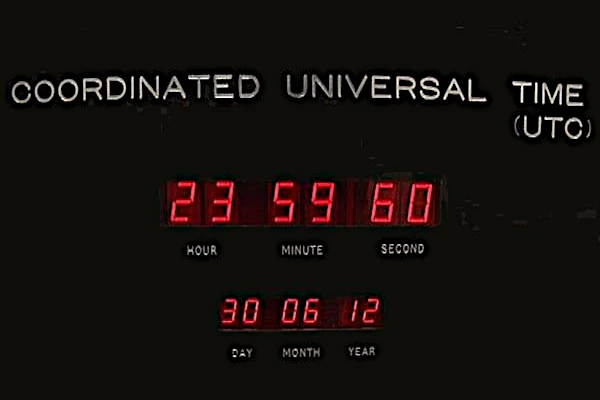
Image description: The Leap Second that is added "at the same instant" worldwide at 23:59:59 UT is counted as 23:59:60, as shown on the computer screen above. The following second is counted as 00:00:00 on the next day. On these days, the 30th of June and the 31st of December concerned have a duration of 86401 seconds instead of the usual 86400 seconds. Leap seconds improve the longitudinal precision of geolocation and terrestrial navigation systems, as well as interoperability with other existing or future GPS systems (Glonass, Galileo, Beidou, MSAS). However, this leap second poses a number of problems because some computer systems are unable to handle leap seconds, and its removal is still under study.
Since 1972, Universal Time (UT) has been the time synchronized with the Earth's rotation. It is measured by precisely observing the passage of distant quasars at the meridian of the observation site with a few corrections. With this method, astronomers achieve a precision on the order of microseconds (10-6 seconds). However, the Earth's rotation on its axis is not regular.
International Atomic Time (TAI) is the time scale based on the definition of the second and is calculated from 349 cesium atomic clocks distributed around the Earth. This reference, used worldwide in real-time, has a precision of 10-10 seconds with cesium 133 (Cs133). This isochronous time for scientific use is called Terrestrial Time (TT).
Given the irregularity of the Earth's rotation, universal time gradually drifts relative to atomic time. This drift is significant, on the order of 35 seconds since 1972. These cumulative micro-drifts are due to the tidal effects of the Moon and the Sun, seasonal variations in ice caps, earthquakes, tsunamis, and various movements of the Earth's inner core. The drifts between the two clocks, UT and TAI, must be corrected; this is why, since 1972, 25 seconds have been added to universal time. These seconds are called leap seconds or additional seconds.
Since the origin of TAI measurement, the International Earth Rotation and Reference Systems Service (IERS) located at the Paris Observatory has only made additions of leap seconds. This leap second is produced from a certain discrepancy between the clocks, ≈0.5 seconds.
The announcement is made in advance by an information bulletin, Bulletin C, published every 6 months. The diffusion is arbitrated by the International Telecommunication Union.
N. B. : In 2015, in France, this leap second occurred with daylight saving time on the morning of July 1st. The clocks displayed 1:59:59, then 1:59:60, then 2:00:00. The addition of this second, correlated with the variations in our planet's rotation, is decided at the global level at the Paris Observatory within the SYRTE1 laboratory.
In 1958, the two clocks, Universal Time (UT1) and International Atomic Time (TAI), were declared synchronous. In 1972, 10 seconds separated them. This initial offset has been maintained, but since then, 25 leap seconds have been added to universal time to correct its drifts.
Between 2016 and 2023, the Earth rotated regularly without any jolts, or more exactly, the drifts in one direction compensated for the drifts in the other direction, and the gap remained constant.
| Year | June 30 | Dec 31 | Year | June 30 | Dec 31 |
| 1980 | 0 | 0 | 2002 | 0 | 0 |
| 1981 | +1 | 0 | 2003 | 0 | 0 |
| 1982 | +1 | 0 | 2004 | 0 | 0 |
| 1983 | +1 | 0 | 2005 | 0 | +1 |
| 1984 | 0 | 0 | 2006 | 0 | 0 |
| 1985 | +1 | 0 | 2007 | 0 | 0 |
| 1986 | 0 | 0 | 2008 | 0 | +1 |
| 1987 | 0 | +1 | 2009 | 0 | 0 |
| 1988 | 0 | 0 | 2010 | 0 | 0 |
| 1989 | 0 | +1 | 2011 | 0 | 0 |
| 1990 | 0 | +1 | 2012 | +1 | 0 |
| 1991 | 0 | 0 | 2013 | 0 | 0 |
| 1992 | +1 | 0 | 2014 | 0 | 0 |
| 1993 | +1 | 0 | 2015 | +1 | 0 |
| 1994 | +1 | 0 | 2016 | 0 | 0 |
| 1995 | 0 | +1 | 2017 | 0 | 0 |
| 1996 | 0 | 0 | 2018 | 0 | 0 |
| 1997 | +1 | 0 | 2019 | 0 | 0 |
| 1998 | 0 | +1 | 2020 | 0 | 0 |
| 1999 | 0 | 0 | 2021 | 0 | 0 |
| 2000 | 0 | 0 | 2022 | 0 | 0 |
| 2001 | 0 | 0 | 2023 | 0 | 0 |